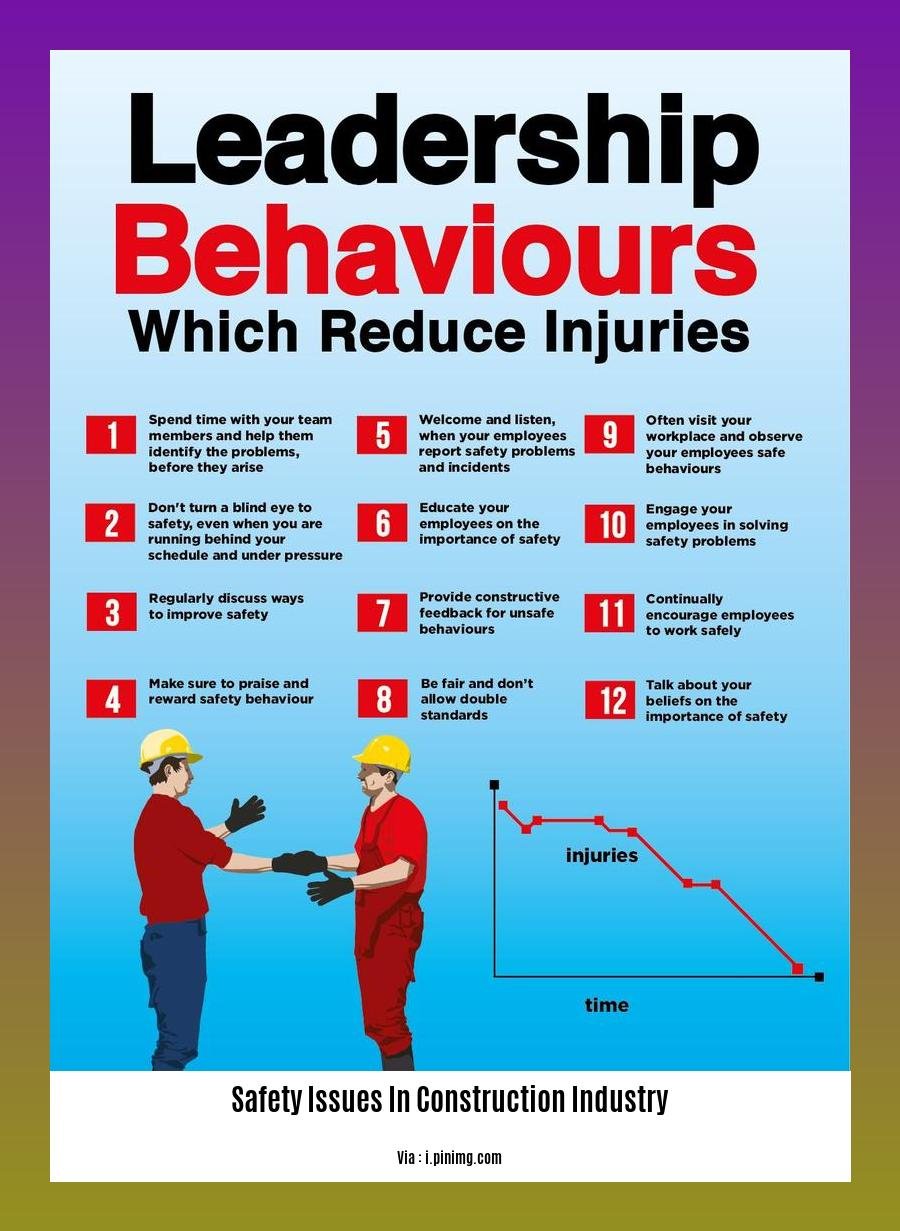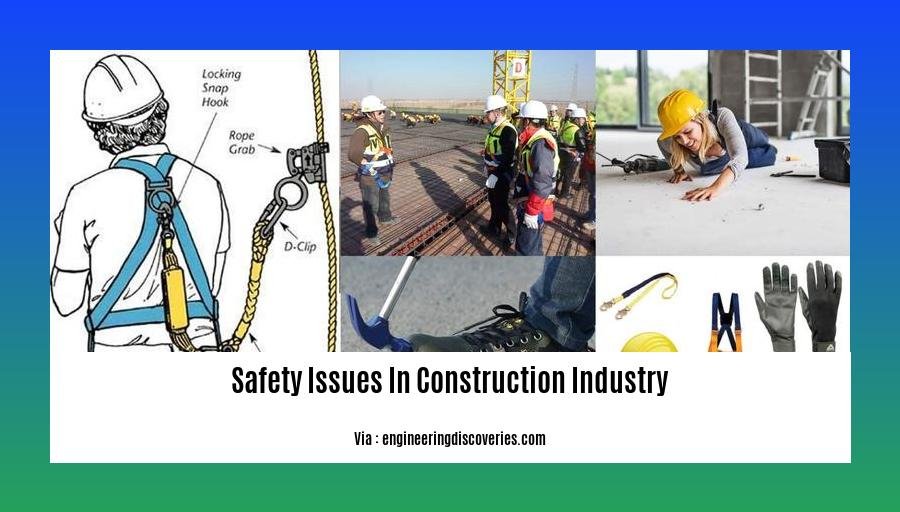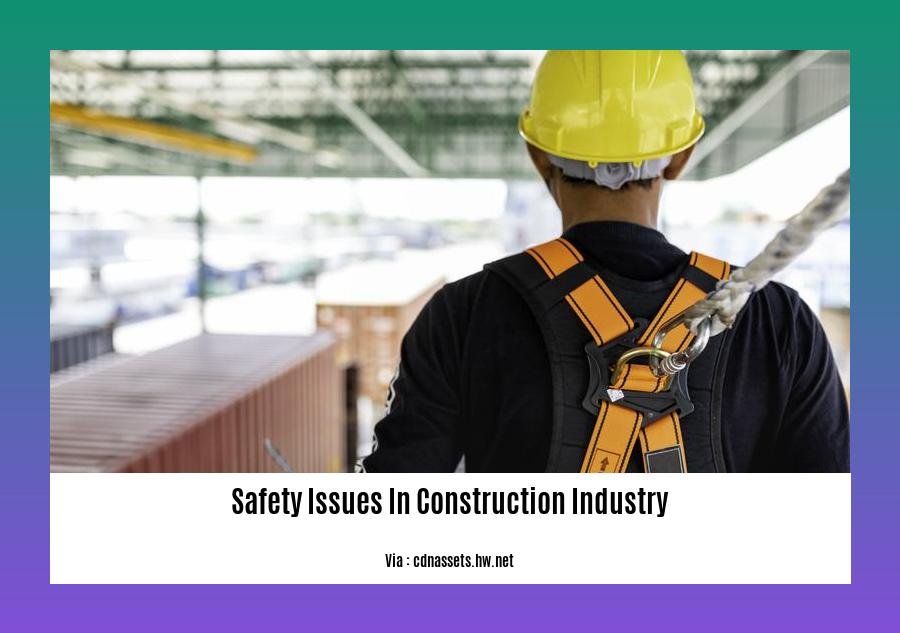**Safety Issues in Construction Industry: A Guide to Hazard Identification and Prevention**
Key Takeaways:
- Mental health awareness is crucial to prevent suicide, the leading cause of death in construction.
- Exhaustion can be a contributing factor to incidents. Promote work-life balance and stress management.
- Working from height requires fall arrest systems and secure platforms to mitigate risk.
- Safe work zones, proper training, and communication are essential to prevent accidents involving moving objects.
- Slips and falls are common injuries; ensure proper housekeeping and safe walking surfaces.
- Noise exposure can lead to hearing damage; use hearing protection and reduce noise levels.
- Repetitive movements can cause Hand-Arm and Wrist Syndrome; use proper tools and take breaks.
- Safe lifting techniques and mechanical assistance prevent muscle strains and back injuries during materials handling.
Safety Issues in Construction Industry

Safety is paramount in any industry, but it’s crucial in construction, where the risks are amplified. Identifying and preventing safety issues in construction industry is essential for safeguarding workers and ensuring project success.
Common Safety Hazards
Construction sites are teeming with potential hazards, including:
- Falls from height
- Moving objects (e.g., heavy machinery, vehicles)
- Slips and falls (due to poor housekeeping or slippery surfaces)
- Noise exposure
- Contact with hazardous materials
- Electrical hazards
Consequences of Safety Negligence
Ignoring safety issues in construction industry can have severe consequences:
- Human Cost: Injuries and fatalities can devastate workers’ lives and families.
- Financial Impact: Accidents lead to lost productivity, medical expenses, and legal liabilities.
- Reputational Damage: Negligence tarnishes a company’s reputation and hampers its ability to attract clients.
Effective Hazard Mitigation
Preventing safety issues in construction industry requires a comprehensive approach:
- Risk Assessment: Identifying potential hazards and assessing their likelihood and severity.
- Hazard Control: Implementing measures to eliminate or minimize hazards (e.g., fall protection systems, proper lighting).
- Training and Education: Providing workers with training on safety protocols and best practices.
- Supervision and Enforcement: Ensuring compliance with safety regulations and holding workers accountable for their actions.
- Continuous Improvement: Regularly reviewing and updating safety measures based on industry best practices and incident reports.
Conclusion
Addressing safety issues in construction industry is a non-negotiable priority. By embracing a proactive approach to hazard identification and prevention, we can create safer workplaces and protect the well-being of construction workers. A safe construction industry is a productive and thriving industry that values human life above all else.
- Safety nets are a critical component of any construction site, and can help to prevent serious injuries or even death in the event of a fall. for more information, visit safety nets for construction sites
-
Here are some examples of safety observations that you can make on a construction site, visit safety observation examples in construction site
-
A safety officer is responsible for ensuring that a construction site is safe for workers and visitors. To know more about what is safety officer construction job description
- The safety officer is responsible for a variety of duties and responsibilities, including: developing and implementing safety plans, conducting safety inspections, investigating accidents, and training workers on safety procedures. To know more safety officer duties and responsibilities in construction
Health And Safety Issues In Construction

Introduction
The construction industry is inherently a high-risk business, and unfortunately, accidents and injuries are all too common. Many causes contribute to this dismal statistic, and it’s imperative to understand these risks to mitigate them effectively.
The Perils of Construction
-
Physically Demanging: Construction work often involves strenuous physical activity, such as heavy-lifting and repetitive movements. These can lead to various musculoskeletal disorders and injuries.
-
Environmental hazards: Construction sites are often filled with dust, noise, and other environmental hazards. These can impact workers’ health and safety in the short and long term.
-
Mental Health: The construction industry has one of the highest suicide rates. The stress, pressure, and uncertainty can overwhelm workers, leading to mental health issues.
-
Fatigue: Long hours, shift work, and physically strenuous work can lead to fatigue, reducing alertness and increasing the risk of errors.
Preventing Construction Site tragedies
To improve Health And Safety Issues In Construction, it is important to take proactive steps to prevent accidents and protect workers. Here are some key measures:
-
Comprehensive Risk Assessment: A thorough risk assessment is essential to identify potential hazards and implement measures to mitigate them.
-
Adequate Training: Providing comprehensive safety training to workers is vital, ensuring they are aware of potential risks and know how to work safely.
-
Proper Personal Protective Equipment: Work sites must provide and ensure their employees wear appropriate personal protective equipment like hard-hat, safety glasses, and gloves to safeguard against potential injuries.
-
Regular Inspections: Consistent and systematic inspections of the work site can ensure that hazards are identified and addressed before they cause an accident.
-
Safety Culture: A robust safety culture should be at the heart of the construction industry. This involves creating a positive attitude towards safety at all levels, from management to workers.
Conclusion
The Health And Safety Issues In Construction are critical and demand attention. Construction companies must be proactive in identifying and mitigating potential hazards. By prioritizing safety, we can significantly reduce accidents and protect our most valuable assets – our workers.
Key Takeaways:
- The construction industry has a high rate of accidents and injuries due to various factors, including physical demands, environmental hazards, mental health, and fatigue.
- To improve safety, comprehensive risk assessment, adequate training, proper personal protective equipment, regular inspections, and a robust safety culture are necessary.
- Addressing mental health issues in the construction industry is vital for improving safety.
- By prioritizing safety, construction companies can significantly reduce accidents and create a healthier work environment for their employees.
Relevant Sources:
-
12 of the Biggest Health and Safety Issues in Construction
-
Health and Safety in Construction – HSE
Construction Safety Osha
Common Construction Industry Hazards
Construction is a vital industry in the United States. However, it’s important to remember that it’s also one of the most dangerous. Construction workers face a variety of hazards on the job, including:
- Falls from heights
- Electrocution
- Struck-by accidents
- Caught-in or caught-between accidents
- Overexertion
Preventing Construction Accidents
There are several things that employers can do to help prevent construction accidents, including:
- Providing safety training to employees
- Enforcing safety rules and regulations
- Inspecting worksites regularly
- Providing personal protective equipment to employees
- Establishing a safety culture
OSHA’s Role in Construction Safety
The Occupational Safety and Health Administration (OSHA) is the federal agency responsible for developing and enforcing workplace safety and health regulations. OSHA has a number of programs and initiatives specifically aimed at improving safety in the construction industry. These include:
- The Construction Industry Outreach Program (CP)
- The National Emphasis Program on Falls in Construction
- The Focus Four Program
Key Takeaways:
- Construction is a dangerous industry, but there are things that employers can do to help prevent accidents.
- OSHA plays an important role in improving safety in the construction industry.
- Workers have the right to a safe workplace.
Citations:
- OSHA Construction Regulations and Construction Safety Compliance
- Top OSHA Violations in Construction (2021)
FAQ
Q1: Why do construction sites have more dangers compared to other work environments?
A1: Construction sites pose a higher risk of hazards due to the presence of heavy machinery, working at heights, and handling hazardous materials.
Q2: What are the most common workplace risks in the construction industry?
A2: Common construction site hazards include falls, electrocution, struck-by incidents, and exposure to hazardous chemicals and dust.
Q3: What are some of the prevalent health and safety issues in construction?
A3: Physical hazards like noise, vibration, and musculoskeletal disorders, as well as mental health concerns like stress and fatigue, are significant health and safety issues in construction.
Q4: How can construction safety be improved?
A4: Establishing a comprehensive safety plan, conducting regular safety audits, providing proper training to workers, and using personal protective equipment are crucial for enhancing construction safety.
Q5: What role does OSHA play in construction site safety?
A5: OSHA sets and enforces safety regulations, conducts inspections, investigates accidents, and provides training and resources to promote safe construction practices.
- Annapolis Mall Map & Directory: Find Stores, Restaurants & More - March 29, 2025
- Angel of Harmony Statue Vandalized at St. Louis Cathedral Basilica - March 29, 2025
- Amur River Maple ( Acer ginnala): A Comprehensive Guide (Including Invasiveness) - March 29, 2025










